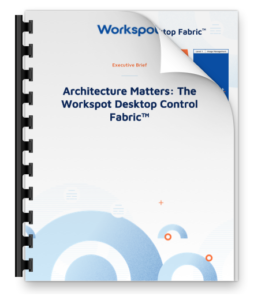Workspot in the News: Empowering DevOps With Cloud Desktops
Workspot was highlighted on DevOps.com with a discussion by VDI industry expert Brad Peterson about how SaaS cloud desktops and GPU cloud workstations can address some vexing DevOps challenges.
Cloud Desktops Empower DevOps
The unification of IT operations and software development teams – DevOps – is a best practice for enabling organizations to accelerate the systems development life cycle. DevOps is more than a set of processes; it is a culture that is based on collaboration and agility, allowing for continuous iteration, innovation and software delivery. Without collaboration, there is no DevOps. At the same time, DevOps as a concept, while not new, is young enough that there is a shortage of people with strong DevOps experience. Cloud desktops and high-performance cloud workstations can help DevOps teams with both of these challenges. Our own John Samuel wrote about his experience supporting a customer’s DevOps use case rollout, and while his story is from 2019, that customer has expanded their Workspot footprint and continues to reap significant agility benefits from their deployment.
Cloud Desktops Free You to Hire Beyond Commute Boundaries
We’ve talked quite a bit about “the great work from home experiment” over the past year. IT and business leaders who were once resistant to allowing remote work have largely come around to support it as the proof of increased productivity has poured in across industries. Productivity has risen, and aside from the trauma visited upon us by the pandemic, people have been happier “life-slicing” during this time. Life slicing describes the notion of work as a “thing we do” rather than a place. Because technology allows us to work anywhere, people can have a much richer work-life experience through having the freedom of navigating back and forth, between their professional work and their personal life, in “slices” of the day.
While there are multiple technologies that support remote working, we believe (as do our customers!) that a cloud-native, SaaS approach to virtual desktops not only reflects the values and culture of DevOps teams, it also affords the greatest opportunity for finding and retaining exactly the right people to add to your team. They can be located anywhere in the world, because pretty much everyone is within 25ms of a public cloud region these days, and that’s all you need to get your new team members up and running now, not weeks from now. Suddenly, you don’t have to hire within commute distance to an office, or open a new office, or ship expensive workstations all over the place. You simply take a few minutes to provision the cloud desktop or workstation configuration that best suits your new team member – in the cloud region closest to them – and they can login to their new cloud desktops and get to work right away.
Now you have access to a whole, new world of great DevOps candidates!
Cloud Desktops Offer Real-Time Collaboration
Now that you can hire the best people all over the world, they need to be able to collaborate effectively. Communication and information sharing must be simple and fast. Some organizations have tried to improve collaboration across dispersed developers using legacy VDI solutions, VPNs, or physical workstations connected over a WAN, but each of these approaches comes with tradeoffs – primarily having to do with security and performance – and that’s not acceptable.
Cloud desktops offer tremendous value for improving collaboration without making any of the sacrifices outdated approaches require. Since data is centralized in the cloud, everyone works from a common, highly secure data set, which ultimately speeds development and improves quality. Blazing fast performance (typically <50ms latency or less!) keeps people happy, motivated and productive. When people don’t have to worry about the technology, they can focus all that energy on creativity.
Another great efficiency benefit for developers is the ability for cloud desktops to support multiple images – no more re-imaging a physical device! This way, developers can easily have multiple desktops, all with differing versions, and all kept completely separate. And depending on the situation, a developer may be assigned either a persistent or non-persistent cloud desktop, whichever meets the criteria set by IT for that person’s role.
DevOps in the Mainstream
As DevOps values and processes gain popularity, cloud desktops and workstations are the perfect fit for supporting the agility goals of DevOps practitioners. Ready to transform software development and delivery in your organization?
Schedule a demo and let’s discuss your unique requirements!



